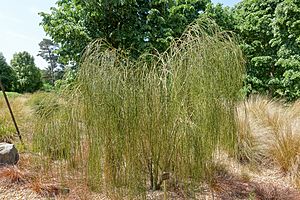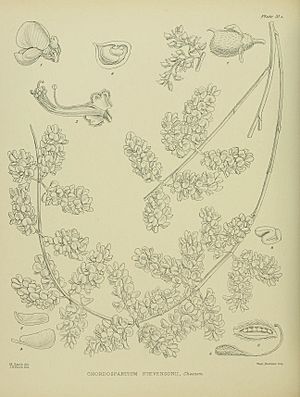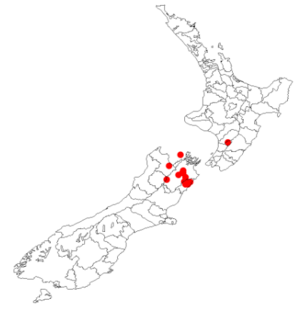Cord broom facts for kids
Quick facts for kids Cord broom |
|
|---|---|
 |
|
 |
|
| Conservation status | |
|
Invalid status (NZ TCS)
|
|
| Scientific classification | |
| Kingdom: | |
| (unranked): | |
| (unranked): | |
| (unranked): | |
| Order: | |
| Family: | |
| Genus: | |
| Species: |
C. stevensonii
|
| Binomial name | |
| Carmichaelia stevensonii (Cheeseman) Heenan
|
|
 |
|
| Occurrence data from AVH | |
| Synonyms | |
|
Chordospartium stevensonii Cheeseman |
|
Carmichaelia stevensonii, also known as the cord broom or weeping broom, is a special type of plant. It belongs to the legume family, which includes peas and beans. This plant is only found in the north-east part of the South Island of New Zealand. Sadly, it is currently threatened because its natural home is being lost.
What is it called?
This plant was first described in 1911 by a scientist named Thomas Frederic Cheeseman. He gave it the name Chordospartium stevensonii. Later, in 1998, another scientist named Peter Brian Heenan studied it again. He decided it fit better into a different group of plants called Carmichaelia. So, its official name became Carmichaelia stevensonii.
Is it in danger?
Yes, this plant is considered to be in danger. In 1998, a group called the IUCN Red List said it was "Vulnerable." This means it faces a high risk of becoming extinct in the wild. The main reason for this is the loss of its natural habitat.
More recently, in 2018, experts in New Zealand looked at the plant's status. They used the New Zealand Threat Classification System. They listed it as "At Risk – Declining." This means its numbers are going down. Protecting its habitat is very important to help this unique plant survive.


